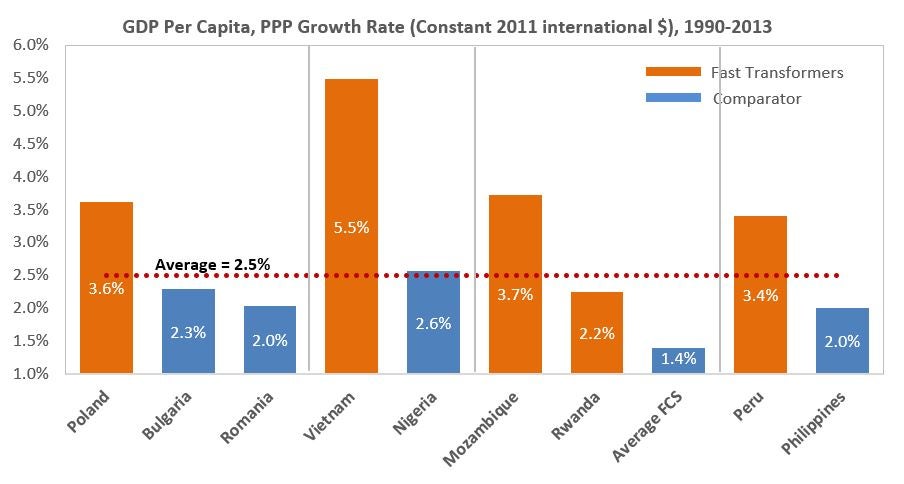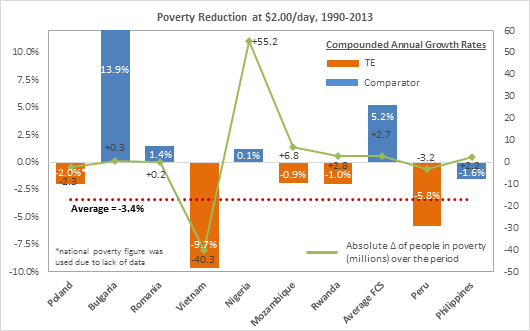What Is a Transformational Engagement?
- Six million Kenyans gained access to electric power from the grid for the first time. Deep reforms also helped restore the Kenyan utility company to profitability and supported sector viability. A further 1.5 million Kenyans gained access to off-grid power while a private market for solar energy devices was created.
- 750,000 Bangladeshi girls gained access to secondary education.
- More than 1.3 million poor Argentinians obtained health coverage and services through an innovative program that rewarded covering the vulnerable.
- More than 14 million Brazilians obtained social assistance through a new delivery mechanism that encouraged use of services by the poor.
- Vietnam's GDP grew at an average of 5.5 percent per capita over a generation, and its poverty rate plummeted, lifting 40 million people out of extreme poverty,through a sustained reform program involving continuous World Bank Group engagement.
These are some of the headlines drawn from engagements at the project, program, sector, and country level that this review covers. They feature the results of interventions to which the World Bank Group contributed, demonstrating the possibility of rapid change toward poverty reduction and social progress. In this report, the Independent Evaluation Group (IEG) reviews the Bank Group's previous experience with such interventions to enhance the knowledge about approaches associated with transformational change.
|
Transformation means different things to different people. Transformational engagements are seen as having the potential to fundamentally change the lives of poor people, to be more ambitious in scope, involving multiple instruments, higher risks, and longer time frames. To apply this concept to Bank Group interventions, IEG defined transformational engagements as interventions or series of interventions that support deep, systemic, and sustainable change with the potential for large-scale impact in an area of a major development challenge. Such engagements help clients remove critical constraints to development, cause of support fundamental change in a system, have large-scale impact the national or global level, and are economically, financially and environmentally sustainable (see below for the four dimensions of the definition).
Why Focus on Transformational Engagements?
The global community has set ambitious objectives to promote sustainable development, end extreme poverty, and promote prosperity. In 2015 the United Nations formally adopted the Sustainable Development Goals, embody a transformational agenda intended to "shift the world onto a sustainable and resilient path". To meet the ambitious goals would require developing countries and their partners to accelerate development progress including through assistance programs that support fundamental, deep change with the potential to reach large proportions of population to accelerate progress.
In this context, the World Bank Group seeks to scale up its development impact by helping its clients catalyze more fundamental or transformational changes. A key challenge is how to increase the World Bank Group's impact, given the huge gap between the magnitude of the development challenges and the resources available to finance and achieve the post-2015 objectives. This implies a need to enhance the impact and effectiveness of interventions, to be more selective regarding the areas in which it intervenes, or to act as a catalyst or connector for transformational change in partnership with others.
Mechanisms and Factors Enabling Transformational Change
The Bank Group has supported successful transformational engagements. We found that these engagements were difficult to do, required sustained efforts over long periods, and were a small share of the Bank Group's portfolio. They can occur in different sectors, country contexts, and vary in size and form.
Among country level engagements selected for this review, transformational countries on average grew much faster than their comparator countries for the entire review period, faster poverty reduction, as well as significantly faster social progress and more equitable distribution of income (or larger declines in income inequality) and sustained progress over a period of time compared to their respective group average and or their respective comparator countries (Figure 2).
Performance of Transformational and Comparator Countries (GDP per capita; poverty headcount, 1990–2013)


However, it is inherently difficult to design for transformation, or even to measure it in hindsight. Development is not a linear, mechanistic process but involves complex and multidimensional processes and interventions in systems, requiring contextualized solutions, adaptation, and active management of change processes.
We concluded that there is no single prescription for catalyzing transformational change. But, IEG identified mechanisms and factors that can increase the likelihood of achieving transformational impact.
Several mechanisms were present in interventions either individually or in combination that showed positive transformational results:
- Binding constraints: Identifying and addressing the binding constraints to progress toward a development objective
- Cross-sectoral approaches: Adopting systemic approaches that address multiple constraints in interrelated parts, including through cross sectoral approaches
- Scaling up innovations: Scaling up and replicating effective approaches and innovations and of novel financing instruments
- Behavioral change: Changing behaviors by modifying incentives of beneficiaries, introducing market forces, or increasing the flow of information.
IEG also identified factors related to the enabling environment and to the design and implementation of interventions. So what did the Bank Group do differently in these engagements to help its clients make them transformational?
- Rigorous diagnosis and analytical work to underpin the design of interventions with the potential to address the context-specific binding constraint or opportunity.
- Adapting interventions to local context, capabilities and social norms is critical in successful transformational engagements.
- Early and broad engagement with stakeholders to forge agreement on common objectives. Building broad coalitions and political consensus—beyond the immediate client counterparts—around reforms was effective in broadening support and maintaining momentum. Successful transformations often were implemented in partnership with other donors, underlining the importance of the Bank Group’s convening role.
- Transforming institutions is at the core of transformational engagements. A focus on building and strengthening local institutions contributed to the sustainability of transformational impacts.
- Comprehensive versus focused program design. The key is to strike the right balance between fostering a strategic understanding of key constraints and then pursue reforms through a set of sequenced and focused interventions. The combination of strategic vision and focused interventions limits complexity of individual projects, but maintains a focus on systemic issues.
- Continuing, sustained engagements and series of interventions. Ongoing support to clients (rather than one-off projects) facilitated the deep reforms associated with transformations by helping build capacity and address several parts of a system through sequential interventions. For the Bank Group, this implies undertaking more selective, programmatic engagements.
- The quality of Bank Group staff and appropriate blending of different instruments and roles. The quality and technical skills and, in some cases, entrepreneurial attitude of Bank Group staff was critical in designing and implementing transformational engagements. However, some evaluations also indicate that the Bank Group’s institutional incentives need adapting to be more fully aligned with helping address the most difficult developing binding constraints.
- Robust monitoring and reporting systems ensure proper targeting of beneficiaries and facilitate learning, as well as adjustments to the project or program during implementation.
Interventions to foster transformational change carry a higher risk, but IEG’s analysis shows that these are well compensated with the results that can be achieved.









